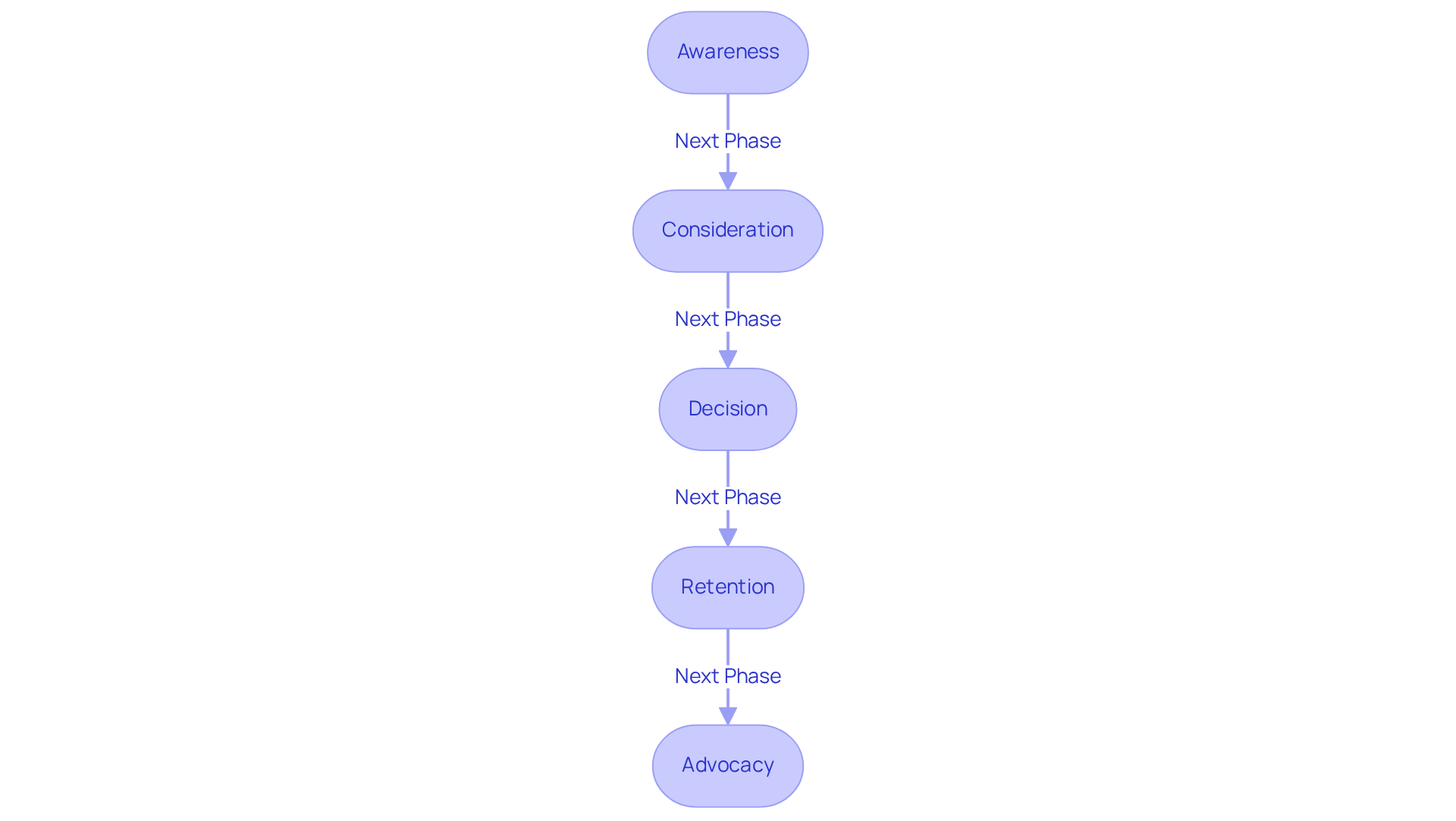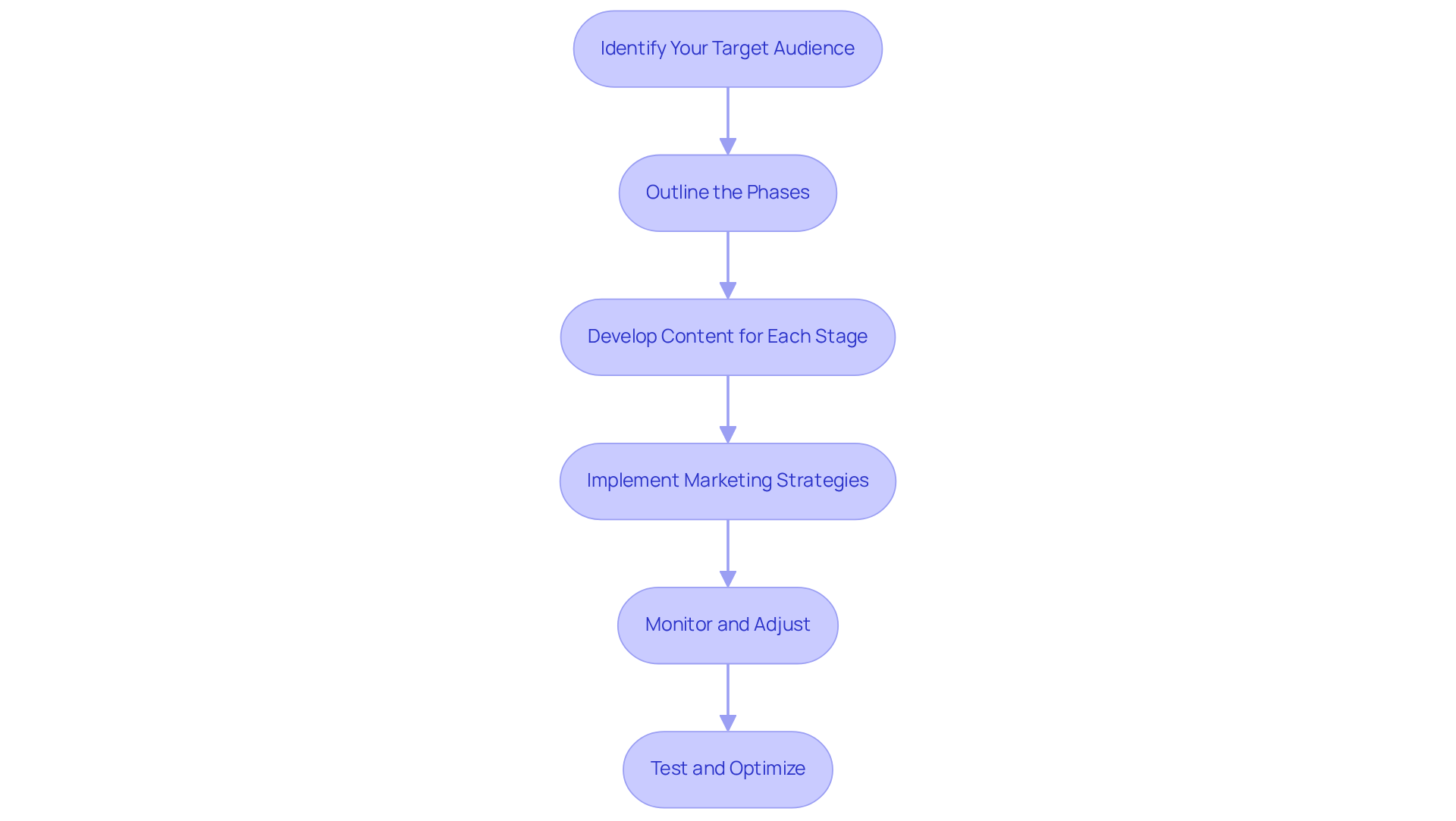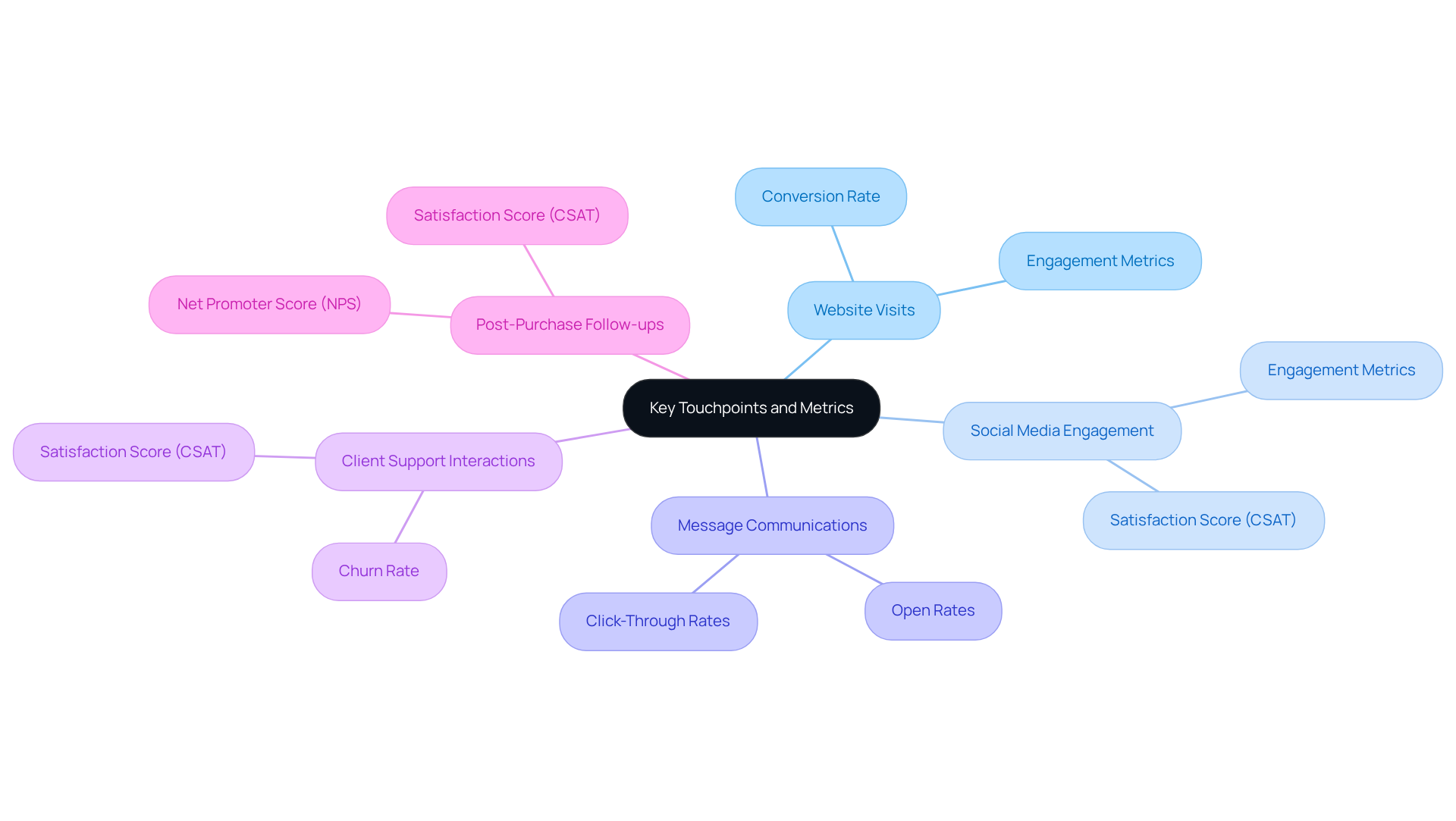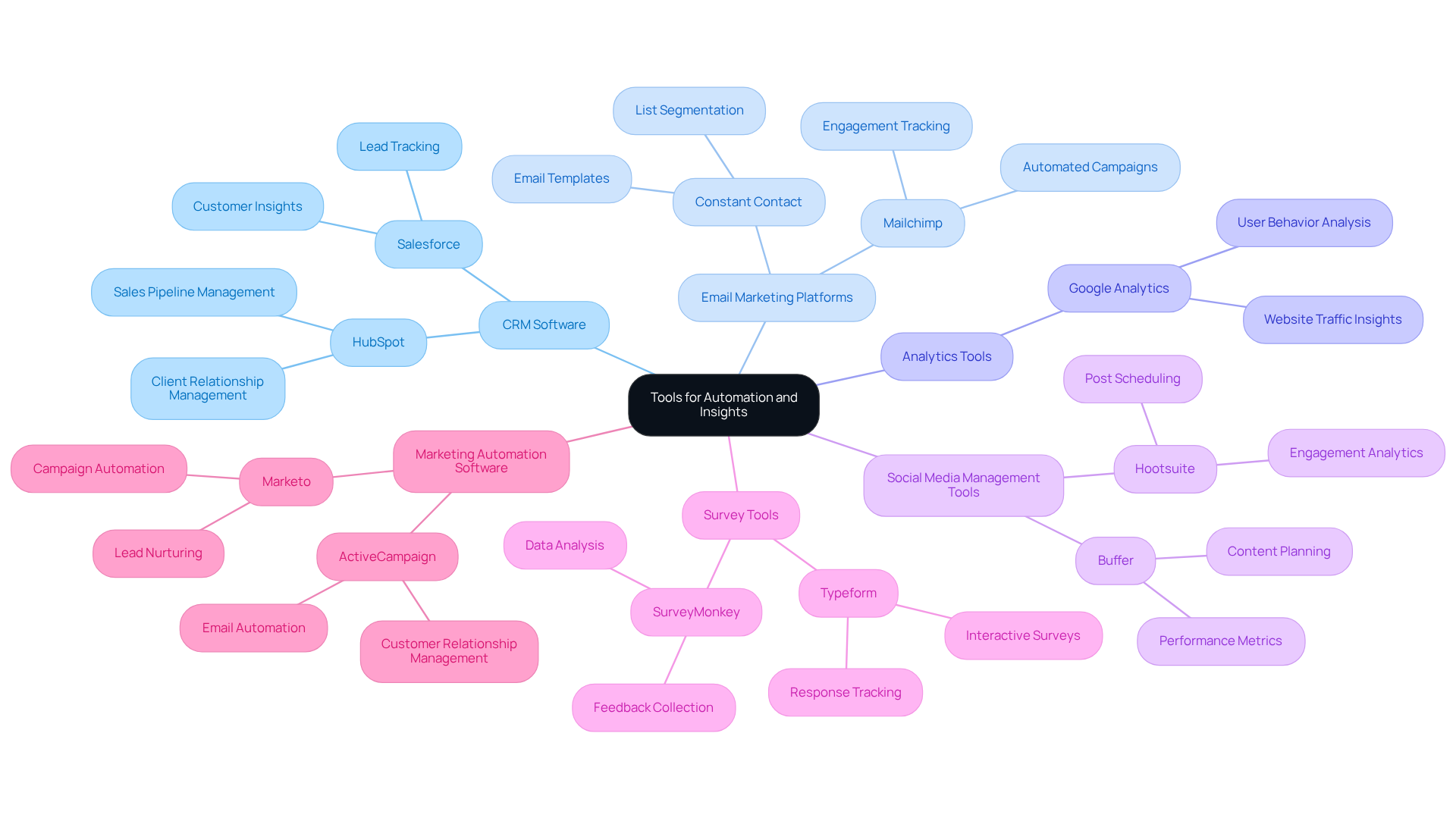Overview
This article is dedicated to helping you master the customer journey funnel, an essential path to success for small businesses. It outlines five crucial phases:
- Awareness
- Consideration
- Decision
- Retention
- Advocacy
Understanding your customers' needs at each stage is vital. By utilizing targeted marketing strategies, supported by tools like Wayy.ai, you can significantly enhance engagement and conversion rates.
As you navigate through these phases, consider how you can connect with your audience. What challenges do they face? How can your business address their concerns? By reflecting on these questions, you can create a more meaningful relationship with your customers. Remember, each phase of the funnel is an opportunity to nurture this connection.
In conclusion, mastering the customer journey is not just about driving sales; it’s about fostering loyalty and advocacy. Together, we can achieve success by understanding and responding to the needs of your customers. Let's embrace this journey with compassion and commitment, ensuring that every step enhances their experience with your brand.
Introduction
Understanding the intricacies of the customer journey funnel is essential for small businesses striving for success in an increasingly competitive landscape. This structured approach not only clarifies the stages a potential client navigates—from initial awareness to becoming a loyal advocate—but also highlights the strategic opportunities for businesses to engage and retain customers effectively.
Yet, as we navigate evolving consumer behaviors and expectations, we must ask ourselves: how can small enterprises ensure they are not just meeting but exceeding client needs at every touchpoint? Together, we can explore these challenges and find ways to empower your business on this journey.
Define the Customer Journey Funnel
The customer journey funnel visually illustrates the phases a prospective client traverses when engaging with your business. It generally includes five essential phases: Awareness, Consideration, Decision, Retention, and Advocacy.
- Awareness: This initial stage is where potential customers first discover your brand or product. Effective marketing strategies such as social media ads, engaging blog posts, and robust SEO efforts can significantly increase visibility. Almost 80% of B2B companies generate leads through content marketing, emphasizing the significance of creating awareness. With , small business owners can receive daily email insights that help track the effectiveness of these strategies, ensuring they reach the right audience.
- Consideration: At this stage, clients evaluate your offerings against competitors. Providing comprehensive product information, authentic testimonials, and compelling case studies can influence their decision-making process. Studies show that client testimonials can boost conversions by 34%, making them an essential resource in this stage. Wayy.ai's insights can assist in identifying which content connects best with prospective clients, enabling targeted modifications.
- Decision: Customers are ready to make a purchase during this stage. Clear calls-to-action, enticing discounts, or limited-time offers can effectively encourage them to finalize their decision. Personalized calls to action perform 202% better than standard ones, underscoring the need for tailored messaging. Wayy.ai can track which offers generate the most interest, helping refine your approach.
- Retention: Post-purchase engagement is crucial for sustaining client loyalty. Follow-up messages, loyalty initiatives, and outstanding client support improve the overall experience. Companies that excel at lead nurturing can shorten their sales cycle by 23%, demonstrating the value of ongoing engagement. With Wayy.ai, small enterprise owners can receive daily email insights that track key metrics such as how many leads were reached, who showed interest, and how conversion rates are improving, further enhancing their retention strategies.
- Advocacy: Happy clients can evolve into brand promoters, endorsing your business through word-of-mouth and referrals. Encouraging reviews and feedback is essential for nurturing this phase, as 81% of consumers are more likely to consider a purchase from a brand they trust. Wayy.ai's insights can help identify pleased clients, enabling targeted outreach to encourage advocacy.
By comprehending these phases and utilizing Wayy.ai's features, small enterprise owners can effectively customize their marketing efforts to address the customer journey funnel, ensuring they fulfill clients' needs at every stage. This strategic approach is increasingly vital in 2025, as businesses adapt to evolving consumer behaviors and preferences.

Outline Steps to Build Your Funnel
Building your customer journey funnel involves several key steps that can truly make a difference for your business:
- Identify Your Target Audience: Understanding who your ideal customers are is essential. By creating detailed buyer personas, you can address their demographics, interests, and challenges. Did you know that 93% of companies that surpass revenue targets segment their database by these personas? This insight can help you connect more deeply with your audience.
- Outline the Phases: Clearly defining each phase of the funnel is crucial for your business's success. Consider utilizing the five phases of the customer journey funnel—Awareness, Interest, Evaluation, Purchase, and Commitment—as a framework for your mapping. This structure can and ensure you don't miss any important steps.
- Develop Content for Each Stage: Tailoring your content to address the specific needs and questions of your audience at each stage is vital. For example, blog posts can generate awareness, comparison guides can aid in consideration, and product demos can facilitate decision-making. Persona-based content can increase customer engagement nearly six times for cold leads. Additionally, 71% of businesses that surpass their revenue and lead generation goals have established buyer personas, highlighting their effectiveness in marketing strategies. Together, we can create content that resonates.
- Implement Marketing Strategies: Utilizing various marketing channels effectively can help you reach your audience at each stage. This may include social media marketing, email campaigns, and paid advertising. Personalized, interactive messaging has a 63% higher chance of generating a response compared to static messaging. Tailoring your outreach efforts can make all the difference in connecting with your customers within the customer journey funnel.
- Monitor and Adjust: Regularly reviewing the performance of your funnel using analytics tools allows you to track client behavior. This ongoing assessment enables you to make necessary adjustments to improve conversion rates. Businesses that consistently refine their funnels can significantly enhance user experiences and achieve better outcomes. Remember, it's a journey we embark on together.
- Test and Optimize: Conducting A/B testing on different elements of your funnel, such as landing pages and email campaigns, is crucial for determining what resonates best with your audience. This iterative process can refine your strategies and maximize engagement, ensuring that your efforts are aligned with your customers' needs.

Identify Key Touchpoints and Metrics
Key touchpoints signify crucial moments when clients engage with your brand during their journey, making their identification vital for enhancing their experience. Understanding these touchpoints can empower you to create a more with your clients. Here are some common touchpoints to consider:
- Website Visits: Often the first interaction, your website should be user-friendly and informative, ensuring visitors feel welcomed and engaged.
- Social Media Engagement: Monitoring interactions on platforms like Facebook, Instagram, and LinkedIn helps you understand how your brand is perceived and fosters a sense of community.
- Message Communications: By keeping an eye on open rates, click-through rates, and responses, you can assess the effectiveness of your message campaigns and adapt to your audience's needs.
- Client Support Interactions: Examining how individuals interact with your support team—whether through chat, telephone, or messaging—can pinpoint areas for enhancement, ensuring clients feel valued and heard.
- Post-Purchase Follow-ups: Assessing the effectiveness of follow-up emails and surveys dispatched after a purchase can significantly improve client satisfaction and retention, showing clients that you care about their experience.
To measure the effectiveness of these touchpoints, consider the following metrics:
- Conversion Rate: The percentage of visitors who complete a desired action, such as making a purchase. In 2025, the average conversion rate for online sales is projected to be around 2-3%. This insight can guide your marketing strategies.
- Satisfaction Score (CSAT): A measure of how pleased clients are with their experience, which can significantly influence repeat purchases. Striving for high satisfaction should be a priority.
- Net Promoter Score (NPS): This metric measures client loyalty and the probability of recommendations, with 92% of individuals trusting referrals from people they know. This highlights the importance of nurturing client relationships.
- Churn Rate: The percentage of clients who cease utilizing your product or service over a specific period, emphasizing the need to maintain strong relationships with your clients.
- Engagement Metrics: Tracking likes, shares, comments, and other interactions on social media and email campaigns can provide valuable insights into audience engagement levels.
Furthermore, businesses employing hybrid sales models experience up to 50% greater revenue growth, underscoring the effectiveness of a multi-channel strategy in client engagement. Remember, while the number of touchpoints is important, the quality and relevance of each touchpoint matter more. After all, 80% of sales require five or more follow-ups, which highlights the need for persistence in nurturing leads. Personalization is no longer optional—it’s an expectation. Mapping the client journey can help you identify gaps and opportunities for enhancement. By concentrating on these essential touchpoints and metrics, small enterprises can improve their client experience, resulting in greater satisfaction and heightened sales efficiency. Together, we can achieve success in fostering lasting relationships with your clients.

Utilize Tools for Automation and Insights
Understanding the can significantly enhance your ability to guide clients through their journey funnel. Here are some tools that can make a difference:
- CRM Software: Solutions like HubSpot or Salesforce are invaluable for managing client relationships and keeping track of interactions throughout the funnel. They help you stay connected with your clients, nurturing those vital relationships.
- Email Marketing Platforms: Services such as Mailchimp or Constant Contact enable you to automate your email campaigns while tracking engagement metrics. This allows you to reach out to your clients in a timely and effective manner.
- Analytics tools, such as Google Analytics, provide insights into website traffic and user behavior, helping you understand how clients navigate your customer journey funnel. This information can be crucial in refining your approach.
- Social Media Management Tools: Platforms like Hootsuite or Buffer assist in scheduling posts and analyzing engagement across social media channels. They ensure your message reaches your audience when it matters most.
- Survey Tools: Tools like SurveyMonkey or Typeform can be used to gather feedback from clients at various stages of their journey. This feedback is essential for improving your services and addressing client needs.
- Marketing Automation Software: Solutions such as Marketo or ActiveCampaign automate marketing tasks and provide insights into client interactions, allowing you to focus on building those important relationships.
By integrating these tools into your business processes, you can streamline your outreach efforts, gain deeper insights into customer behavior, and ultimately enhance your sales performance. Together, we can navigate these challenges and achieve success.

Conclusion
Understanding the customer journey funnel is essential for small businesses striving for success in a competitive marketplace. This framework not only outlines the stages a prospective client goes through—from Awareness to Advocacy—but also highlights the importance of tailoring marketing strategies to meet customer needs at every phase. By mastering this funnel, we can enhance our engagement efforts, ultimately leading to increased conversions and customer loyalty.
The article delves into the five critical phases of the customer journey:
- Awareness
- Consideration
- Decision
- Retention
- Advocacy
It emphasizes the significance of utilizing effective marketing strategies, developing targeted content, and leveraging analytics tools to monitor performance. Key touchpoints and metrics provide insights into how we can refine our approach and foster lasting relationships with clients. Moreover, the integration of automation tools streamlines processes, ensuring that we can respond effectively to customer interactions.
Ultimately, investing time and resources into understanding and optimizing the customer journey funnel is not just a strategy—it's a necessity for small businesses looking to thrive. As consumer behaviors continue to evolve, adapting to these changes through personalized engagement and data-driven insights will be crucial. Let's embrace this journey together and leverage the tools at our disposal to create meaningful connections with our customers, ensuring their satisfaction and loyalty for years to come.
Frequently Asked Questions
What is the customer journey funnel?
The customer journey funnel visually represents the phases a prospective client goes through when engaging with a business, typically including five phases: Awareness, Consideration, Decision, Retention, and Advocacy.
What happens during the Awareness phase?
In the Awareness phase, potential customers first discover the brand or product. Effective marketing strategies, such as social media ads, engaging blog posts, and SEO efforts, are crucial for increasing visibility.
How do businesses generate leads in the Awareness phase?
Almost 80% of B2B companies generate leads through content marketing, highlighting the importance of creating awareness. Tools like Wayy.ai can help track the effectiveness of these strategies.
What occurs in the Consideration phase?
During the Consideration phase, clients evaluate a business's offerings against competitors. Providing comprehensive product information, authentic testimonials, and compelling case studies can influence their decision-making.
Why are client testimonials important in the Consideration phase?
Client testimonials can boost conversions by 34%, making them an essential resource for influencing potential customers during this stage.
What is the focus of the Decision phase?
In the Decision phase, customers are ready to make a purchase. Clear calls-to-action, enticing discounts, or limited-time offers can effectively encourage them to finalize their decision.
How can personalized calls to action impact customer decisions?
Personalized calls to action perform 202% better than standard ones, highlighting the importance of tailored messaging to encourage purchases.
What strategies are important in the Retention phase?
Post-purchase engagement through follow-up messages, loyalty initiatives, and excellent client support is crucial for sustaining client loyalty.
How can businesses benefit from lead nurturing in the Retention phase?
Companies that excel at lead nurturing can shorten their sales cycle by 23%, demonstrating the value of ongoing engagement with clients.
What is the Advocacy phase about?
The Advocacy phase involves happy clients becoming brand promoters who endorse the business through word-of-mouth and referrals.
How can businesses encourage customer advocacy?
Encouraging reviews and feedback is essential, as 81% of consumers are more likely to consider a purchase from a brand they trust.
How can Wayy.ai assist small business owners in the customer journey funnel?
Wayy.ai provides daily email insights that help track key metrics, identify effective content, and refine marketing strategies to address the customer journey funnel effectively.




